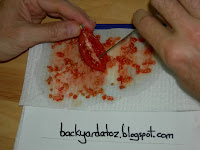Saving your own seeds from a spectacular tomato or huge pumpkin that you grew can be fun. It is quite something to skite about to say, "it's my own variety". Not all vegetables are easy to collect seed from, a number are hybrids and require the original parents to reproduce the same plant. However, whilst the result may not be guaranteed, sometimes that is part of the fun too - you never quite know what's around the corner, perhaps it might be the new, improved version...
Tomato and pepper, are perhaps the easiest to keep seed from. Mature seed is darker in colour and will have a higher germination percentage and produce more vigorous plants next season.
These Heirloom Roma Tomato are very fleshy and were great on home-made pizza. I definitely want to keep seed for next year.
Take a knife and slice the fruit down the centre, prising the seed from the jelly. Leave behind the fleshy part of the fruit.
The seed should be spread out thinly over an absorbant paper and then placed in a warm dry space.
If you have room the linen cupboard is great...
Short Green Cucumber - also called American slicer types grow well in outdoor vegetable gardens.
This cucumber plant battled through the hot summer without too much powdery mildew. I'll give it another go next season.
Once the leaves have died off and the stalks are dry, pumpkin can be harvested.
This self-set 'Crown' pumpkin grew with little to no care and has produced some nice fruit.
There are plenty of seed to dry for next year.
Once the seed is removed from the centre, clean away as much of the 'flesh' as possible and store in a dry place. Pumpkin are a large seed and will take longer than smaller seed like tomato to dry.
When dry, place in an air-tight jar and store in a cool location until spring.
Celery can be open pollinated or hybrid. My celery went to seed early this summmer as a result of the hot dry conditions. Rather than pull them out I decided to leave in place and let the seed mature.
Once the seed heads had turned brown I cut the seed stalks from the plant and placed in a paper bag to dry.
After the seed had dried, shake the seed from the seed heads onto a paper towl and then store in an air-tight jar.
My parents saved these seed from their parsnip plants. The process was similar as per the celery above.
Saving and swapping seed is a great way to both retain your favourite fruits and vegetables from one season to the next and also to save money. If you swap with friends or relatives, then it's both cost effective and adds a bit of competition - see who can grow the best one!
Good Growing.
Tomato and pepper, are perhaps the easiest to keep seed from. Mature seed is darker in colour and will have a higher germination percentage and produce more vigorous plants next season.
These Heirloom Roma Tomato are very fleshy and were great on home-made pizza. I definitely want to keep seed for next year.
Take a knife and slice the fruit down the centre, prising the seed from the jelly. Leave behind the fleshy part of the fruit.
The seed should be spread out thinly over an absorbant paper and then placed in a warm dry space.
If you have room the linen cupboard is great...
Short Green Cucumber - also called American slicer types grow well in outdoor vegetable gardens.
This cucumber plant battled through the hot summer without too much powdery mildew. I'll give it another go next season.
Once the leaves have died off and the stalks are dry, pumpkin can be harvested.
This self-set 'Crown' pumpkin grew with little to no care and has produced some nice fruit.
There are plenty of seed to dry for next year.
Once the seed is removed from the centre, clean away as much of the 'flesh' as possible and store in a dry place. Pumpkin are a large seed and will take longer than smaller seed like tomato to dry.
When dry, place in an air-tight jar and store in a cool location until spring.
Celery can be open pollinated or hybrid. My celery went to seed early this summmer as a result of the hot dry conditions. Rather than pull them out I decided to leave in place and let the seed mature.
Once the seed heads had turned brown I cut the seed stalks from the plant and placed in a paper bag to dry.
After the seed had dried, shake the seed from the seed heads onto a paper towl and then store in an air-tight jar.
My parents saved these seed from their parsnip plants. The process was similar as per the celery above.
Saving and swapping seed is a great way to both retain your favourite fruits and vegetables from one season to the next and also to save money. If you swap with friends or relatives, then it's both cost effective and adds a bit of competition - see who can grow the best one!
Good Growing.








No comments:
Post a Comment